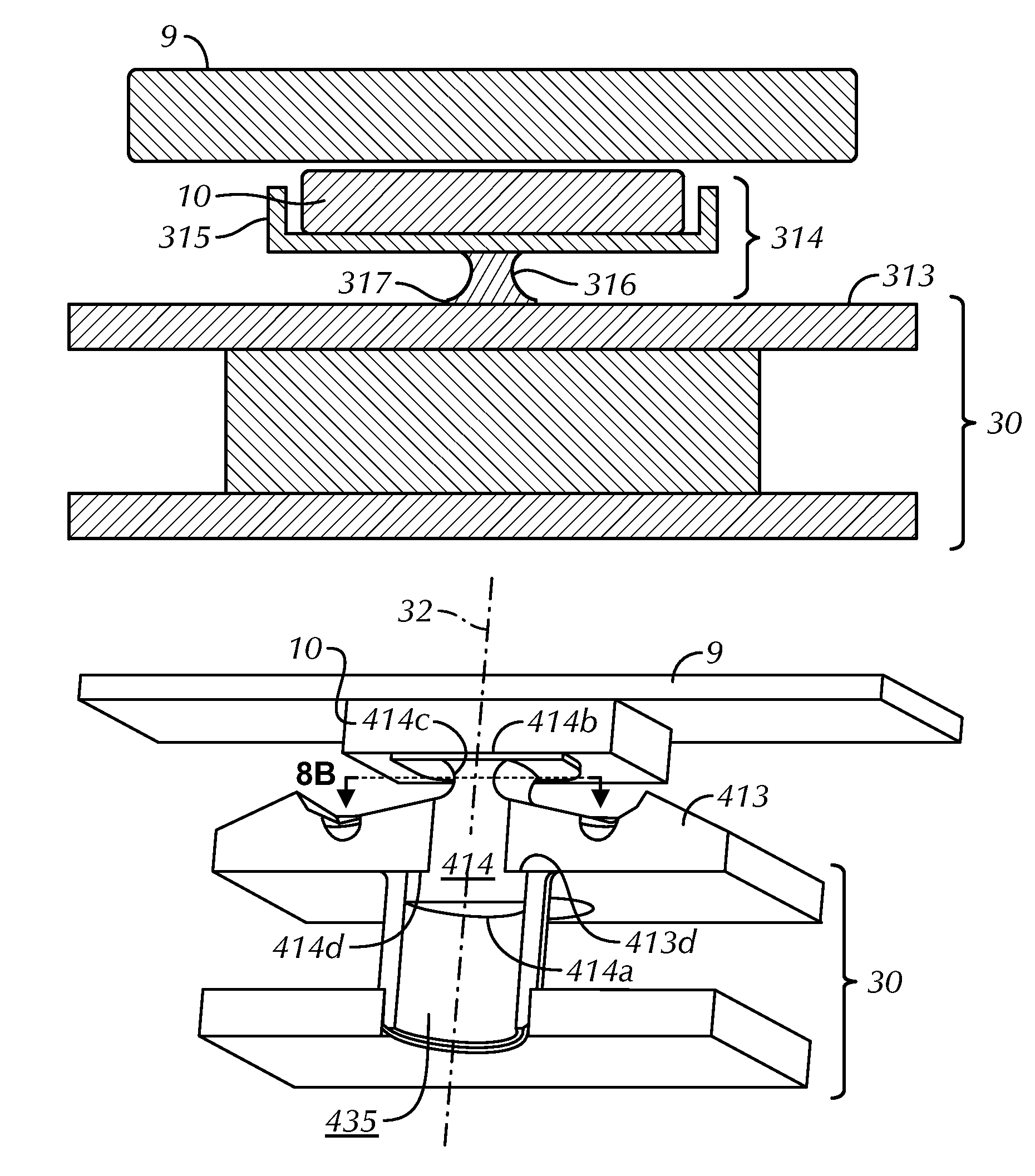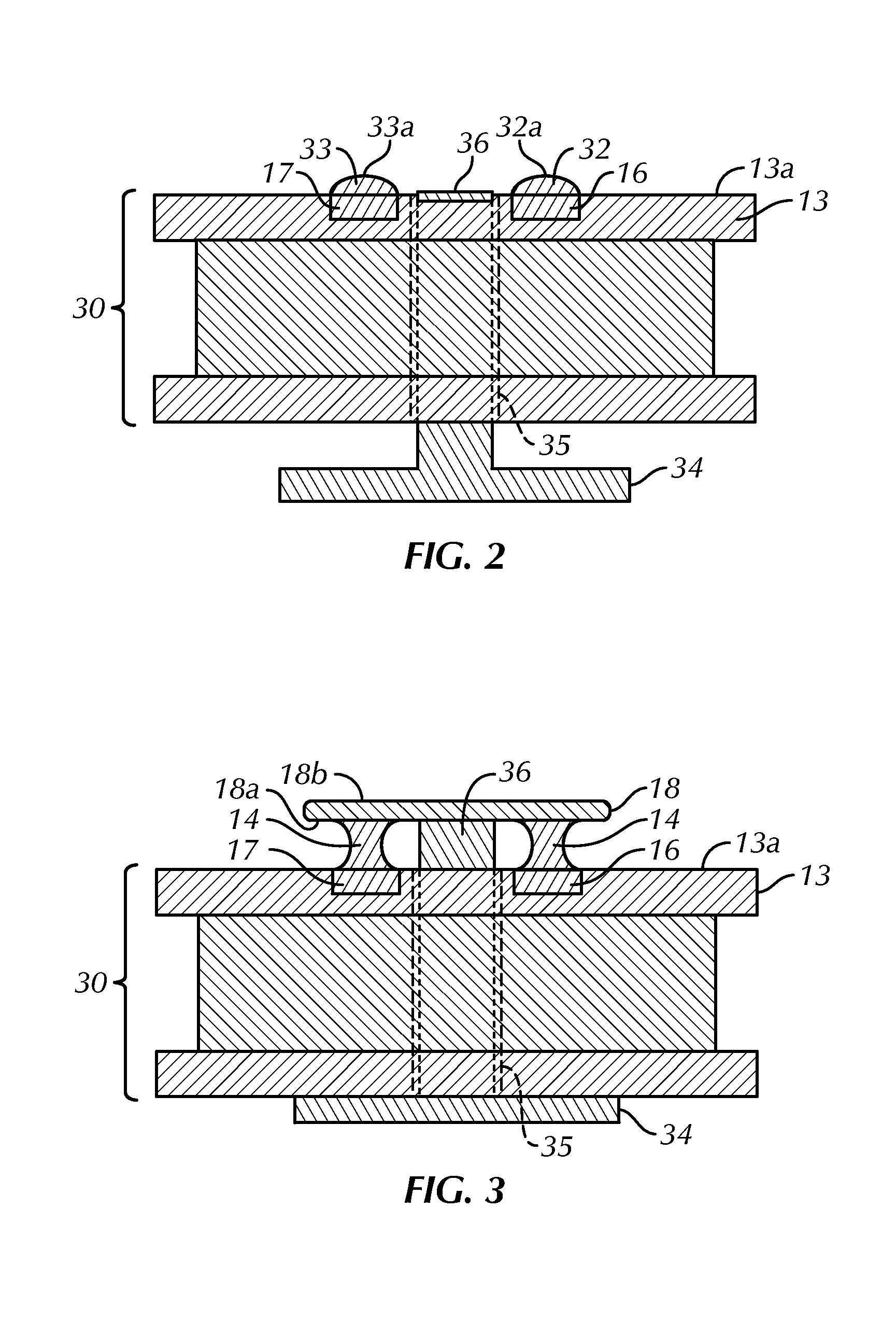Scan element for use in scanning light and method of making the same
a scanning element and light beam technology, applied in the direction of optics, dynamo-electric machines, instruments, etc., can solve the problems of unbalanced structure, unbalanced hinges, unwanted tilting or drooping of scan mirrors,
- Summary
- Abstract
- Description
- Claims
- Application Information
AI Technical Summary
Benefits of technology
Problems solved by technology
Method used
Image
Examples
second embodiment
[0039]An alternate method of forming the elastomeric supports 14 will now be described. FIG. 4 shows a substrate 70, in accordance with the invention, preferably formed from a non-magnetic material, such as phosphor bronze or beryllium copper alloy. Holes 72a and 72b are etched through the substrate 70. The holes 72a, 72b are preferably oblong in shape, but may be etched having other known shapes. Alternatively, the substrate 70 may be molded to form the holes 72a, 72b. Surrounding the holes 72a, 72b are respective first oblong shaped land areas 73a, 73b followed by partially etched second oblong areas 71a, 71b. The second oblong areas 71a, 71b are preferably etched half way through a thickness of the substrate 70.
[0040]Pockets 16, 17 formed in the surface 13a of the flange 13 (i.e., FIG. 1) are preferably shaped to match the holes 72a, 72b in the substrate 70. The pockets 16, 17 are filled evenly with liquid RTV silicone elastomeric compound. Once the pockets 16, 17 are filled, sub...
third embodiment
[0042]FIG. 5 illustrates the present invention wherein a bobbin 80, preferably formed of molded plastic, includes two molded flexible inserts 81a, 81b preferably formed of injection molded silicone rubber. FIG. 6 shows a cross-sectional view of the bobbin 80 with a flange 82. Molded inserts 81a, 81b each preferably include a shoulder 83a, 83b that anchors the respective inserts 81a, 81b into the bobbin flange 82. Atop the inserts 81a, 81b are further mounting ribs 84a, 84b, which may be shaped, for example, to fit the holes 72a, 72b of the mounting substrate 70 in FIG. 4. Mounting features 84a, 84b are preferably secured to the holes 72a, 72b using liquid adhesive (such as liquid silicone RTV resin), but may also be secured by a mechanical lock fitting or the like.
fourth embodiment
[0043]FIG. 7 shows the present invention wherein an elastomeric support 314 is shaped to hold the magnet 10 within a pocket 315 integrally formed as part of the support 314. A middle portion 316 of the support 314 flexes as described above in other embodiments, and a base portion 317 of the support 314 may be attached to a flange 313 of the bobbin 30 using anchoring methods described above.
[0044]In a preferred embodiment, the base portion 317 of the elastomeric support 314 is molded into bobbin flange 313 to firmly anchor the support 314, thereby creating a high immunity to detachment damage resulting from drops or the like. Molded insert 81a and shoulder 83a (FIG. 6) show an exemplary form of anchoring. The magnet 10 is preferably glued into the pocket 315, but may also be mechanically pressed or locked into the pocket 315. If the elastomeric support 314 is molded from silicone rubber, then the magnet 10 may be glued using liquid RTV silicone to form an exceptionally strong bond. T...
PUM
| Property | Measurement | Unit |
|---|---|---|
| distance | aaaaa | aaaaa |
| magnetization | aaaaa | aaaaa |
| area | aaaaa | aaaaa |
Abstract
Description
Claims
Application Information
 Login to View More
Login to View More - R&D
- Intellectual Property
- Life Sciences
- Materials
- Tech Scout
- Unparalleled Data Quality
- Higher Quality Content
- 60% Fewer Hallucinations
Browse by: Latest US Patents, China's latest patents, Technical Efficacy Thesaurus, Application Domain, Technology Topic, Popular Technical Reports.
© 2025 PatSnap. All rights reserved.Legal|Privacy policy|Modern Slavery Act Transparency Statement|Sitemap|About US| Contact US: help@patsnap.com



